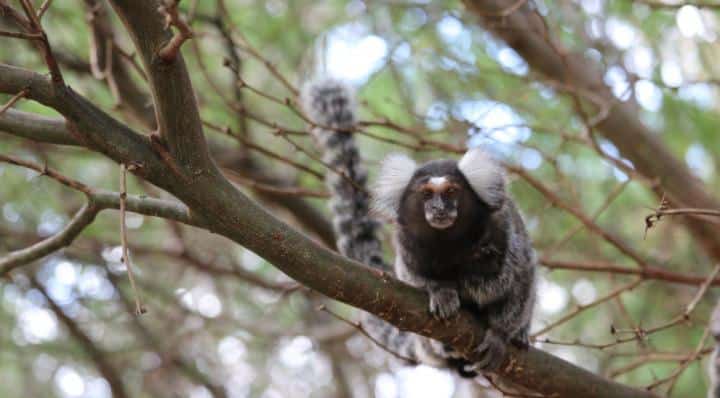Summary: A new study sheds light on personality traits in marmoset monkeys.
Source: University of Vienna
In humans, differences in personalities have been evident since the ancient times. Personality in animals has long been ignored, but recently this question has received increasing research interest as it has been realized that personality has evolutionary and ecological significance. An international team of behavioral biologists from Austria, Brazil and the Netherlands, with Vedrana Å lipogor from the University of Vienna as leading author of the study, designed a set of tasks to assess personality of common marmosets.
These results have just been published in American Journal of Primatology.
Marmosets are small highly social New World monkeys that parallel humans in their social organization, as they live in cohesive family units, where parents act as breeders and their offspring help them raise the young. The researchers showed that captive monkeys living in Austria as well as those monkeys living under natural conditions in semi-arid Caatinga forests of Northeastern Brazil show consistent differences in their personalities, similarly to humans.
In the personality tasks, the monkeys could explore and engage with a familiar environment, new foods, new objects, and situations mimicking a predatory situation (e.g. encountering a plastic toy snake or a strange-looking object). The researchers carefully observed these monkeys’ reactions in the tasks, for instance when trying a piece of jackfruit or engaging with a colorful rattle shaped toy.
Some individuals were fast to approach any novelty, while others were more careful; hereby showing a similar pattern to humans: for instance, some humans enjoy trying out new restaurants, whereas others prefer to eat in their favorite restaurant. What is more interesting, when comparing personality traits of monkeys in Austria across four years, the authors found that these monkeys are quite consistent in their personality traits (e.g., those that are explorative when they are younger, stay similarly explorative four years afterwards).
The only exception to this rule were monkeys who changed their breeding status in the family units.
“We have found that those monkeys who became breeders, that is, dominant individuals in the group, also became bolder”, says Vedrana Šlipogor, a postdoctoral fellow at the University of Vienna.

“In humans and other non-human animals we see a similar pattern. People effective in leading positions often show higher levels of extraversion, as well as some other traits (e.g., high agreeableness and conscientiousness and low neuroticism). In homing pigeons, it has been shown that bolder individuals have a higher rank in the hierarchy and are likely to influence direction of collective movement, and subordinate field crickets who change their status to dominant, also show an increase in boldness, exploration and activity.”
It is especially interesting that this is the first time that researchers captured personality in wild marmoset monkeys.
“We adapted our test battery from the well-controlled captive setting to the unpredictable conditions in the wild. In the wild, monkeys have plenty of things to do in their day-to-day lives, however, and in exchange for some bananas, they decided to participate in these tasks. We were pleased to discover that wild monkeys show a very similar personality structure as those in captivity”, says Thomas Bugnyar, Professor of Cognitive Ethology at the University of Vienna and senior author of the study.
“This gives further support that consistent variation in individuals can be reliably assessed with our personality test battery, both in captive and wild settings. It also gives us more confidence that we provide the best possible conditions to our monkeys in Austria, as they show such striking similarity to the marmosets in Brazil”.
About this animal psychology research news
Source: University of Vienna
Contact: Vedrana Šlipogor – University of Vienna
Image: The image is credited to Vedrana Šlipogor
Original Research: Open access.
“Temporal consistency and ecological validity of personality structure in common marmosets (Callithrix jacchus): A unifying field and laboratory approach” by Šlipogor, V., Massen, J.J.M., Schiel, N., Souto, A., Bugnyar, T. American Journal of Primatology
Abstract
Temporal consistency and ecological validity of personality structure in common marmosets (Callithrix jacchus): A unifying field and laboratory approach
Personality in animals has been extensively researched in recent decades. Temporal consistency of behaviors is almost always part of the personality definition and is usually explored in several different testing sessions or observation periods. However, it is still unclear whether the obtained personality constructs are stable across several years, which might be especially important for long‐living animals, such as primates. Further, little is known on whether the personality structures obtained in the laboratory reflect the structures obtained under ecologically relevant conditions in the wild. Therefore, we conducted a battery of personality tests on common marmosets (Callithrix jacchus) (N = 27), compared it with a test battery conducted 4 years beforehand on a subset of animals in captivity (N = 13) and ran an adapted version under field conditions at Baracuhy Biological Field Station, Brazil (N = 18). Under captive conditions, we found a remarkably similar personality structure across 4 testing years. Further, we found high long‐term temporal consistency in the first two personality components, Boldness and Exploration; however, monkeys that changed their social (i.e., breeding) status between the two testing periods showed a significant increase in Boldness scores. Under field conditions, we found a somewhat similar personality structure as compared to the laboratory, which to some extent corroborates ecological validity of our personality test design. Nevertheless, whether the structure in the wild is suppressed or expanded in comparison to captivity, and in which way the social setting influences personality structure, should be further explored. Taken together, our results contribute to the discussion about the reliability and ecological validity of personality structures in nonhuman primates.






